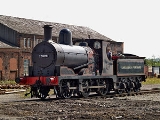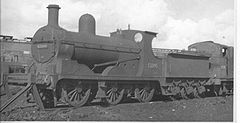
L&YR Class 27
Encyclopedia
The Lancashire and Yorkshire Railway
(L&YR) Class 27 is a class of 0-6-0
steam locomotive
designed for freight work.
and 484 were built between 1889 - 1918 at Horwich works. The Class 27 was the standard goods engine of the Lancashire & Yorkshire Railway. Aspinall opted for the two cylinder format with a non superheated round top boiler. David Joy's configuration of valve gear was employed. By the time of Aspinall's departure from the L&YR in 1899 over 400 of these simple but powerful engines had been built. More were built under his successor Henry Hoy
and George Hughes
, albeit with some modifications. By 1918 the class totalled 484.
 It was under Hughes that the class became the subject of early experiments in superheating
It was under Hughes that the class became the subject of early experiments in superheating
. This was the process of increasing the temperature of the steam produced in the boiler so the minimum of energy was lost.
After many months of trials a further 20 superheated engines were authorised to be built and the first of these superheated class 27's emerged from Horwich Works in 1909.
The superheated 27's retained the boiler pressure of the originals (180 psi
). This first batch had round topped boilers but in 1912 a second batch of 20 was constructed with Belpaire fireboxes.
Although the class was augmented by a further 60 engines between 1900 and 1909 with another ten added in 1917-18, the final five built reverted entirely to the original 1889 specification. It is a tribute to the soundness, usefulness and simple practicality of Aspinall's design that some 300 of the class passed into the hands of the LMS and around 50 were still in British Railways service as late as the summer of 1960.
One, 1896-built L&YR number 1300 (later LMS 12322 and BR 52322) has survived to preservation on the Ribble Steam Railway
.
, designed by George Hughes
.
Lancashire and Yorkshire Railway
The Lancashire and Yorkshire Railway was a major British railway company before the 1923 Grouping. It was incorporated in 1847 from an amalgamation of several existing railways...
(L&YR) Class 27 is a class of 0-6-0
0-6-0
Under the Whyte notation for the classification of steam locomotives, 0-6-0 represents the wheel arrangement of no leading wheels, six powered and coupled driving wheels on three axles, and no trailing wheels...
steam locomotive
Steam locomotive
A steam locomotive is a railway locomotive that produces its power through a steam engine. These locomotives are fueled by burning some combustible material, usually coal, wood or oil, to produce steam in a boiler, which drives the steam engine...
designed for freight work.
Construction and operation
They were designed by John AspinallJohn Aspinall (engineer)
Sir John Audley Frederick Aspinall was a British mechanical engineer who served as Locomotive Superintendent of the Great Southern and Western and Lancashire and Yorkshire Railways. He introduced vacuum brakes to his locomotives in Ireland, a trend which was followed in Britain, and designed...
and 484 were built between 1889 - 1918 at Horwich works. The Class 27 was the standard goods engine of the Lancashire & Yorkshire Railway. Aspinall opted for the two cylinder format with a non superheated round top boiler. David Joy's configuration of valve gear was employed. By the time of Aspinall's departure from the L&YR in 1899 over 400 of these simple but powerful engines had been built. More were built under his successor Henry Hoy
Henry Hoy
Henry Albert Hoy was a locomotive engineer with the Lancashire and Yorkshire Railway . Hoy was born on 13 January 1855 in London, and educated at King Edward VI's Grammar School in St Albans, and at St John's College, Liverpool University....
and George Hughes
George Hughes
George Hughes may refer to:*George Edward Hughes , Professor of Philosophy at the Victoria University of Wellington*George Hughes , former NFL player*George Hughes , British locomotive engineer...
, albeit with some modifications. By 1918 the class totalled 484.
Superheating

Superheating
In physics, superheating is the phenomenon in which a liquid is heated to a temperature higher than its boiling point, without boiling...
. This was the process of increasing the temperature of the steam produced in the boiler so the minimum of energy was lost.
After many months of trials a further 20 superheated engines were authorised to be built and the first of these superheated class 27's emerged from Horwich Works in 1909.
The superheated 27's retained the boiler pressure of the originals (180 psi
Pounds per square inch
The pound per square inch or, more accurately, pound-force per square inch is a unit of pressure or of stress based on avoirdupois units...
). This first batch had round topped boilers but in 1912 a second batch of 20 was constructed with Belpaire fireboxes.
Although the class was augmented by a further 60 engines between 1900 and 1909 with another ten added in 1917-18, the final five built reverted entirely to the original 1889 specification. It is a tribute to the soundness, usefulness and simple practicality of Aspinall's design that some 300 of the class passed into the hands of the LMS and around 50 were still in British Railways service as late as the summer of 1960.
One, 1896-built L&YR number 1300 (later LMS 12322 and BR 52322) has survived to preservation on the Ribble Steam Railway
Ribble Steam Railway
The Ribble Steam Railway is a standard gauge preserved railway in Lancashire, in the United Kingdom. It was opened to the public on 17 September 2005, running along Preston Docks,...
.
The rebuild
The Rebuild of the Class 27 was the L&YR Class 28L&YR Class 28
The Lancashire and Yorkshire Railway Class 28 is a class of 0-6-0 steam locomotive, designed by George Hughes. It is the rebuild of Aspinall's Class 27, due to the addition of a Belpaire firebox and the extension of the footplate and front sandboxes. It is similar, but superheated...
, designed by George Hughes
George Hughes (engineer)
George Hughes was a locomotive engineer, and Chief Mechanical Engineer of the Lancashire and Yorkshire Railway and the London, Midland and Scottish Railway.-L&YR:...
.

